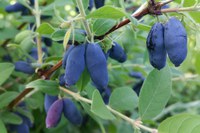Dakota Gardener: The best new fruit for the Dakotas
(Click an image below to view a high-resolution image that can be downloaded)
By Tom Kalb, Horticulturist
NDSU Extension
It’s fun to grow new fruit crops.
Common fruits like apples and strawberries are okay, but there’s nothing special about them. It’s more exciting to grow—and taste—an exotic, new fruit.
I have seen lots of promising fruits over the past 15 years in North Dakota. These include seaberry, silverberry, lingonberry, goji berry, goumi, kiwi, blackberry, mountainash, pawpaw, and the list goes on.
They all disappoint. Many of these crops can’t survive our cold winters. The other crops ripen too late or grow on branches with vicious thorns. A few of the crops grow well but taste terrible.
One new fruit crop has stood out in our gardens. It is easy to grow and tastes delicious. This fruit is the haskap, also called honeyberry.
It’s easy to grow haskaps. They can survive our worst winters. They have no major insect pests or diseases. Haskaps thrive in our prairie soils.
Millions of haskap shrubs are grown in the prairie provinces of Canada. Any crop that can survive the Canadian prairie will survive in the Dakotas.
Best of all, haskaps are absolutely delicious. The fruits are larger and sweeter than blueberries. They taste like blueberries with essences of raspberries and cherries. The fruits have thin skins and will melt in your mouth!
Speaking of blueberries, they are almost impossible to grow here. Our soils are too alkaline, our winters are too cold, and our climate is too dry. Most blueberry shrubs planted in our state will die within a couple years.
Forget about blueberries. We’ve got haskaps to grow.
Many of us have never eaten a haskap before. That’s because they are hard to grow on commercial fruit farms. The fruits do not ripen uniformly and have a tendency to drop when ripe. This makes mechanical harvesting very difficult.
Breeders from North Dakota State University, the University of Saskatchewan and fruit companies are working to develop varieties that can be harvested mechanically. Progress is being made, but it is slow.
Gardeners don’t have to worry about mechanical harvesting. We can go out to our backyards and harvest the fruits as they ripen and before they drop to the ground.
The biggest challenge when growing haskaps are birds. Haskaps are the first fruits to ripen and birds love them. You must place netting over the shrubs a couple weeks after flowering to shield the fruits from birds.
Haskap plants are becoming more available at local garden centers, and several companies sell the plants online. These include HoneyberryUSA, One Green World, Haskap Oregon and Jung. Do a search on Google and you can find more sources.
You need to plant at least two compatible varieties for cross-pollination and maximum yields. When buying a haskap plant, look to see which variety your plant is compatible with.
The most promising varieties in our North Dakota State University trials come from Japan. These shrubs are productive and easy to harvest due to their upright habit and sparse foliage. These promising varieties include Solo and Maxie of the Yezberry series, Opus, Kawai and Keiko.
If you are looking for a new fruit crop, I encourage you to try haskap. It is easy to grow and tastes yummy!
For more information about gardening, contact your local NDSU Extension agent. Find the Extension office for your county at www.ndsu.edu/agriculture/extension/county-extension-offices.
NDSU Agriculture Communication – June 4, 2025
Source: Tom Kalb, 701-877-2585, tom.kalb@ndsu.edu
Editor: Kelli Anderson, 701-231-6136, kelli.c.anderson@ndsu.edu




